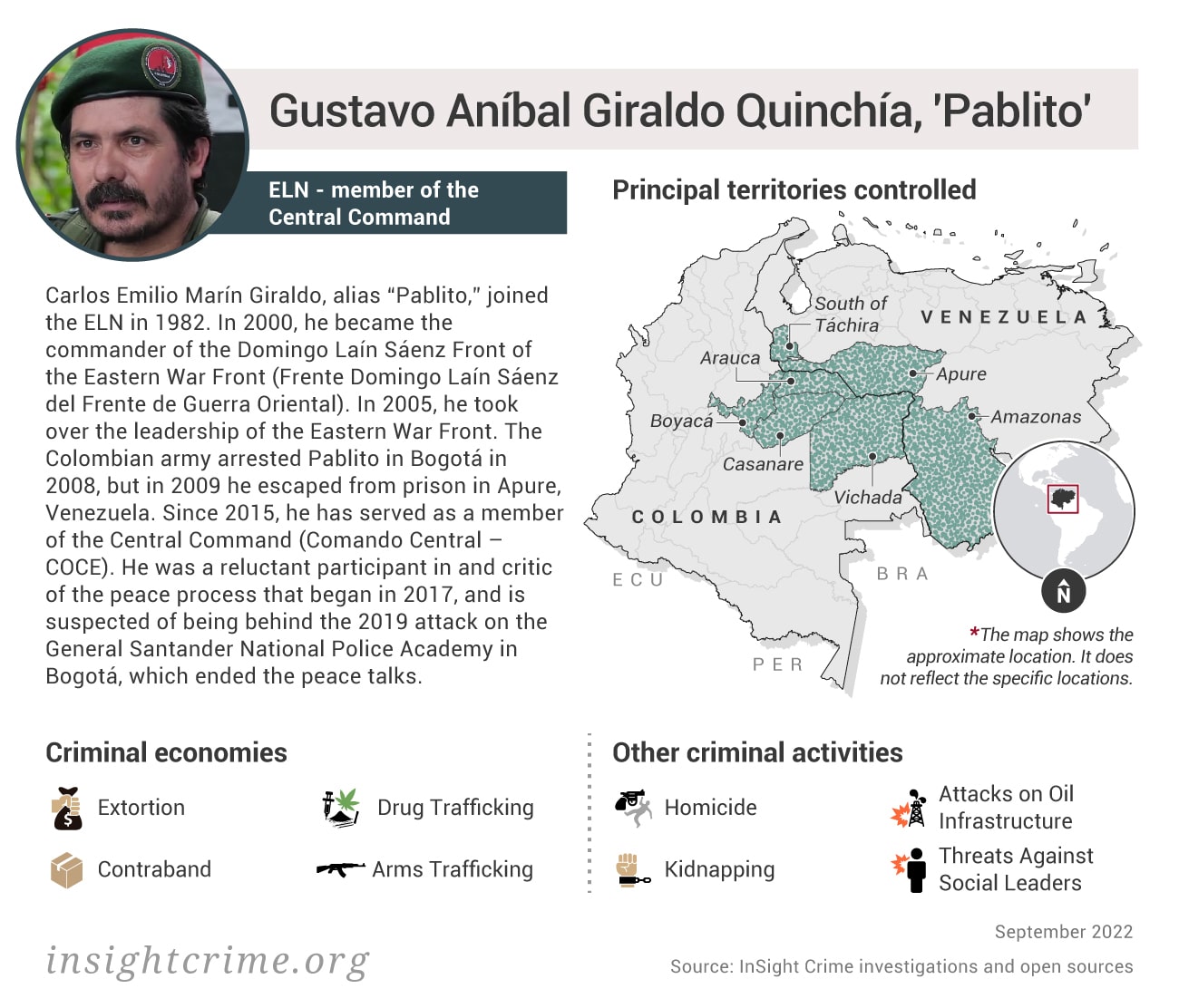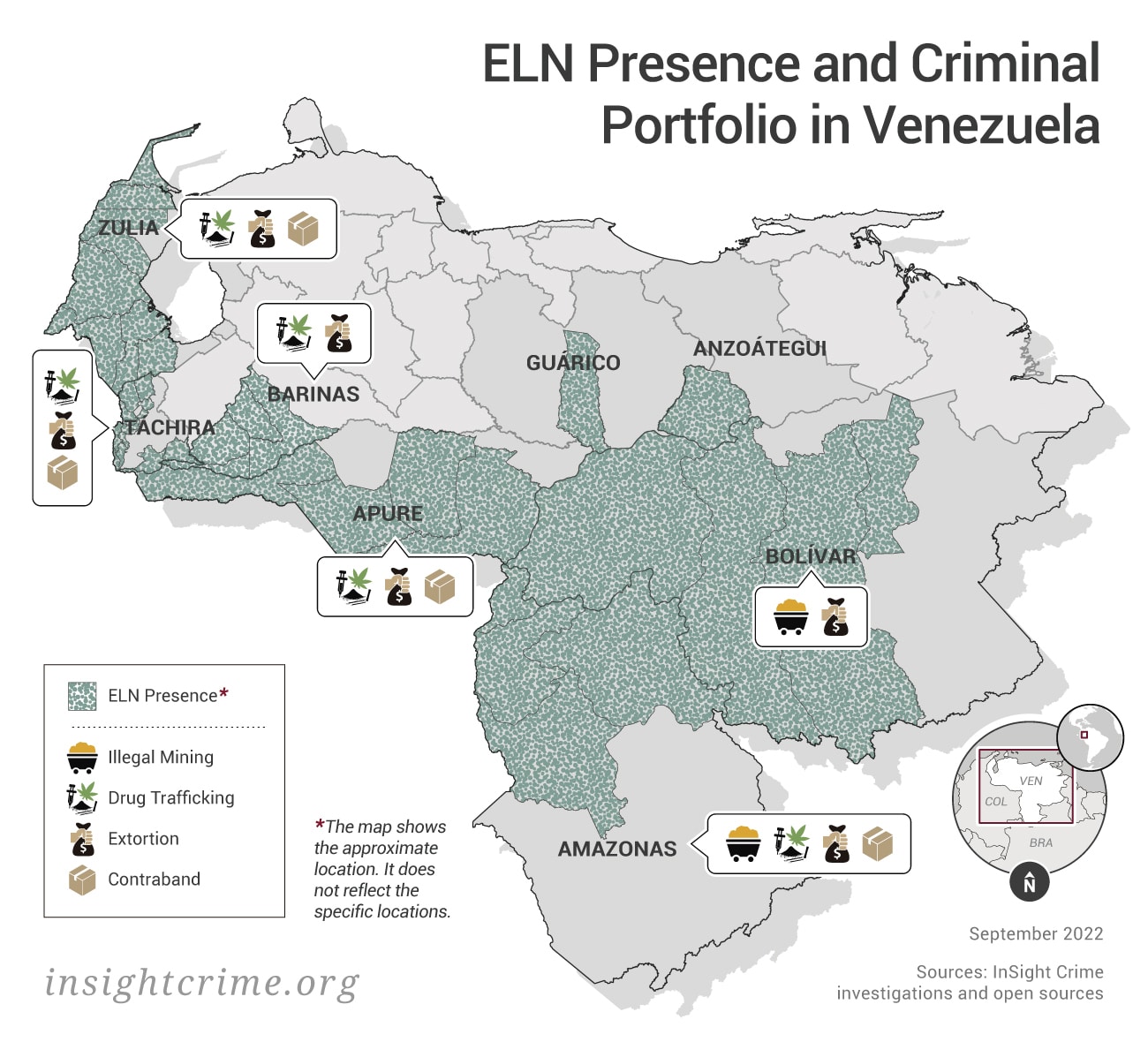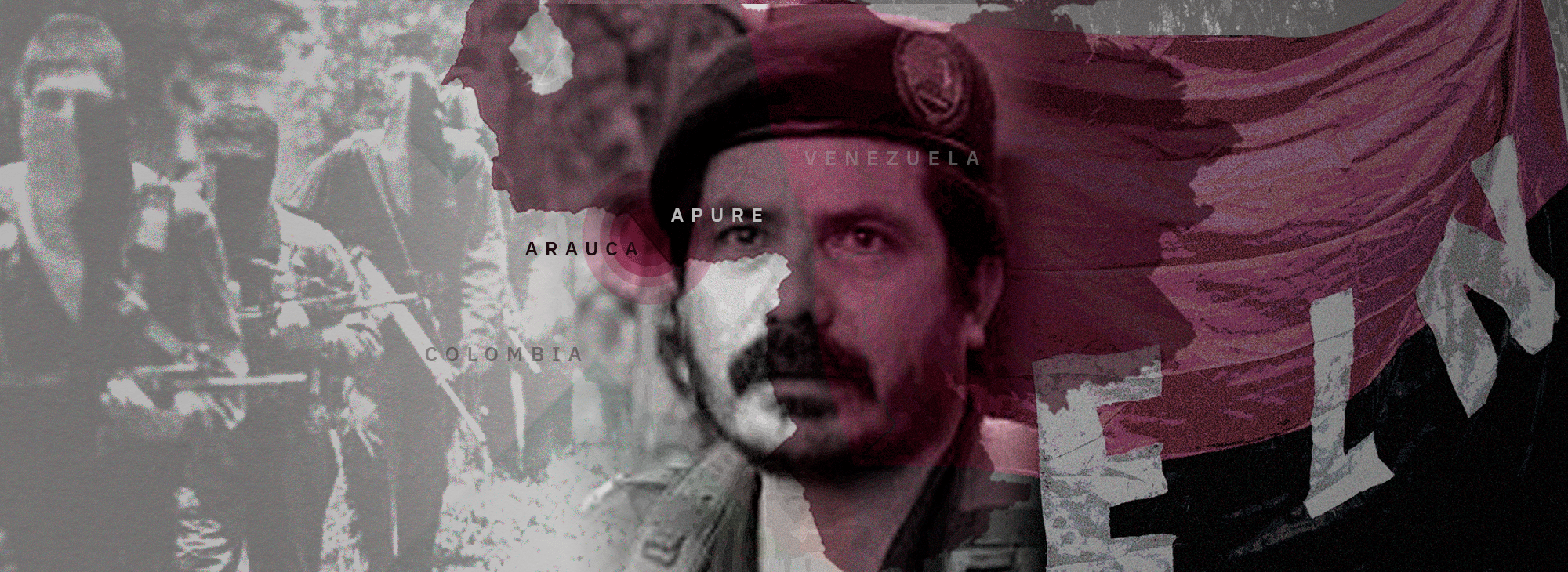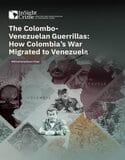On the morning of October 7, 2009, prison guards in the west Colombian state of Arauca were tasked with a simple but terrifying task: transfer to Bogotá one of Colombia’s most notorious prisoners, the National Liberation Army (Ejército de Liberación Nacional – ELN) commander Gustavo Aníbal Giraldo, alias “Pablito.”
As they were preparing to leave, a woman in a bullet-proof vest pulled up on a motorbike in front of the prison gates, according to accounts from the time. While her escorts unleashed a barrage of gunfire, she tossed Pablito a gun. He shot and killed his guard, broke free, and was bundled into the back of a waiting Toyota truck. Within minutes, Pablito had crossed the Arauca river into Venezuela.
But Pablito not only fled to Venezuela, he moved his operations there. And he brought the most successful insurgency model in the ELN’s history with him. He built up his forces in the western Venezuelan state of Apure while laying down deep roots in local communities and establishing far-reaching ties to the Venezuelan state.
SEE ALSO: Profile of Gustavo Aníbal Giraldo, alias ‘Pablito’
Then in 2016, the ELN was presented with an historic opportunity: Its guerrilla cousins, the Revolutionary Armed Forces of Colombia (Fuerzas Armadas Revolucionarias de Colombia – FARC), signed a peace agreement with the Colombian government. The FARC had set up even more extensive operations in Venezuelan territory than the ELN and built ties to the state that ran to the very top. Their promise to disarm and demobilize would leave a power vacuum in a swathe of strategically important territories rich in criminal economies on both the Colombian and Venezuelan sides of the border.
Pablito recognized the opportunity and pushed hard to seize it. In doing so, he would help turn the ELN into the most powerful insurgency in the Americas and the strongest non-state armed actor in Venezuela. Simultaneously, he positioned himself as one of the most powerful commanders in the ELN leadership.
“He is the [guerrilla commander] that is the most consolidated, has the most people, and the most presence in Venezuela,” Sebastian Zuleta, an expert in peace negotiations and the Colombian conflict, told InSight Crime. “I don’t think you can understand the expansion of the ELN without understanding the role of Pablito.”
Pablito’s Migration
At the time Pablito fled to Venezuela, he was overseeing a complex military-political insurgency machine based in the eastern border state of Arauca that far eclipsed anything the ELN had managed to build anywhere else in the country.
The Eastern War Front (Frente de Guerra Oriental – FGO) was the richest front in the ELN, largely thanks to its extortion of the oil sector. It was also the most militarily powerful.
Not only did Pablito command fearsome guerrilla units, he also oversaw a militia network embedded in the civilian population. Its members collect intelligence, channel communications, manage criminal economies and networks of front businesses, and carry out assassinations and hit-and-run attacks against Colombian security forces.
Pablito and his front wove themselves into the fabric of society in Arauca. They coopted civil society by infiltrating social movements. They captured local politics by getting hand-picked governors and mayors elected. And they set themselves up as the de facto authorities in communities throughout the state, imposing their own rules, regulations, and social norms enforced at gunpoint.

This was the model that Pablito brought to Venezuela when he escaped prison in 2009.
By that time, the ELN were no strangers to the country. They had been crossing the border since as far back as the 1970s. After the election of leftist firebrand Hugo Chávez created a friendly environment for Colombia’s insurgents in the border region, Pablito’s Eastern War Front began setting up operations and taking territory in the Alto Apure region and along the banks of the Arauca river separating the two countries.
But when Pablito crossed the river, Venezuela went from being the Eastern War Front’s hideout to serving as its command center for both military and financial operations. And that command center was protected by the Venezuelan state.
When InSight Crime first visited the region in 2011, one Colombian oil sector contractor described how he had to cross the river into Venezuela to make extortion payments at an office run by the ELN. When it was time to renegotiate the terms of their agreement, he was summoned to a meeting with Pabilto himself, who was operating out of a ranch near the Apure town of El Nula. The ranch, according to local rumor, had been expropriated by the Chávez government and donated to Pablito.
As Pablito had done in Arauca, his arm of the ELN inserted itself into the social fabric of local communities in Apure.
These days, their urban militia networks keep close tabs on communities they control, according to residents who spoke to InSight Crime on condition of anonymity for fear of angering the guerrillas. The guerrillas’ social control extends as far as domestic disputes and cases of infidelity, residents say. The rebels are also spreading their ideology through local schools, where children are taught about imperialism, class struggle, and the legitimacy of the ELN’s revolution.
“It has been a job of ideological and psychological softening up,” a journalist in Alto Apure, who did not want to be identified for fear of reprisals, told InSight Crime. “They have been winning over the population as the ‘good guys’ who treat the community well, who help them when they’re sick and provide social support. And this helped them penetrate the population.”
New Underworld, New Opportunities
Three years after Pablito fled to Venezuela, the FARC started peace talks with the Colombian government, spurring the ELN to start planning for huge changes in guerrilla dynamics.
The ELN launched a dual strategy: war and peace at the same time. After years of backchannel talks, the ELN leadership formally announced their own peace process with the government in 2016. But they were also waging an expansion campaign of unprecedented ambition, to capitalize on the vacuum soon to be left by the FARC.
SEE ALSO: How Many Colombian Fighters are Really Inside Venezuela?
Pablito by this time had been appointed a member of the ELN’s Central Command (Commado Central – COCE). But while the rest of the COCE decamped to Havana, Cuba for the talks, Pablito, cynical of the prospects for peace and a reluctant backer of the process, remained in the field, where he was at the forefront of the military expansion.
“Pablito was not even interested in the process, and so he took advantage of the obvious disconnection between the COCE in Havana and the political and military structures in Colombia and Venezuela to make these structures grow in the way he wanted,” said Zuleta, who has previously advised the Colombian government on peace talks with the ELN.
The Eastern War Front expanded southwards, in both countries, moving into new territories in the states of Vichada in Colombia and Amazonas in Venezuela. The Front, by this time operating as a fully binational group, used strikingly different approaches in each country.
In Venezuela, the Front used the methods developed in Arauca: establishing a military presence and building up urban militia networks while coopting communities and elements of the state.
Heavily armed, uniformed guerrillas set up camps and presented themselves to communities as defenders of the Bolivarian Revolution and friends to the local population, residents told InSight Crime.
“They spoke to the community leaders to offer their services, saying they were going to support us and provide security,” said a cultural leader from the indigenous Huottöja community in Amazonas.
As they have expanded in Venezuela, they have also strengthened by recruiting Venezuelans — among them minors — multiple sources in several different border states told InSight Crime.
“The guerrillas sweeten them up by offering them work, offering to pay them, and as we are in this situation where there is no work, they go with enthusiasm,” said a religious leader in an ELN-dominated municipality in Apure, who spoke to InSight Crime on condition of anonymity.
In Colombia, by contrast, the ELN’s advance was quiet. The group did not set up camps, but it did establish intelligence networks, according to police, government officials, and residents in Vichada’s capital, Puerto Carreño. Instead of coopting communities, it set up front businesses and used them to launder money and secure supplies. Now, the soldiers only come to the Colombian side to traffic drugs, murder enemies, recruit — or take off their uniforms and hit the bars.
The ELN guerrillas in Vichada are “100% Venezuelan,” Colonel Edilberto Garcia, commander of the Colombian National Police in Vichada told InSight Crime.
“They have been based in Venezuela for many years, and they have very strong connections there,” Garcia said.
In addition to the Eastern War Front, the Northeastern and Northern War Fronts also led similar advances into former FARC territories along the border and into Venezuela, expanding into the states of Norte de Santander and La Guajira in Colombia, and into Táchira and Zulia in Venezuela.
“Just when we thought we were free of these groups, these new ones we don’t know arrive,” a municipal official in San Juan de Cesar, La Guajira, told InSight Crime in a 2018 interview.
Again, the expansion was binational, and again the ELN moved into new territories in Venezuela using the military-social-political model perfected by Pablito. During InSight Crime investigations in ELN territory in Venezuela, sources described the same patterns: social control, political outreach, construction of community networks — and the armed menace behind it all.
As the expansion gathered pace after the FARC demobilized throughout 2017, both the Eastern War Front and the other War Fronts began to move far beyond the former FARC territories and into Venezuela’s interior, setting up operations in states such as Anzoátegui, Barinas, Guárico, and even near the eastern border in the gold mining hub of Bolívar.
In many of these new territories, the ELN used violence as a tool of expansion, often with the tacit or even overt blessing of the Venezuelan state.
The ELN confronted rivals and enemies up and down the border, and even in interior states. They have battled, among others, Colombian paramilitary successor groups such as the Rastrojos and the Urabeños, as well as the Venezuelan megabanda Tren de Aragua in Táchira, the mining gangs known as sindicatos (unions) in Bolívar, and La Zona, a smuggling gang based in the Guajira region of Zulia.
The guerrillas honed their tactics through decades of warfare in Colombia. They have directly assaulted their rivals, and they have picked them off with assassinations. They have undermined their enemies’ public support by murdering and displacing suspected “collaborators,” and they have solidified their own control by waging “social cleansing” campaigns targeting anyone not abiding by their code of conduct or identified as potential obstacles to their advance.
“For a while, fear reigned here,” a resident of the Amazonas town of Puerto Ayacucho, who did not want to be identified for security reasons, told InSight Crime. “By six o’clock, everyone was shut up in their houses, and [the guerrillas] would take away anyone who was still on the streets.”
The biggest battle of the ELN’s binational expansion, though, would be with the group whose position they were seeking to usurp — the remnants of the FARC, known as the ex-FARC mafia, which had also been trying to fill the vacuum in Venezuela left by the guerrilla demobilization.
Pablito had successfully taken on the FARC before. Between 2005 and 2011, he directed a conflict with the FARC’s 10th Front that marked the bloodiest episode of Arauca’s brutal history. The ELN held off a militarily superior enemy by withdrawing their forces to Venezuela, while ruthlessly attacking the civilian population in FARC-controlled areas and sharing intelligence with the Colombian military, which used the information to take out the FARC leadership, according to an account of the conflict by researcher Charles Larratt-Smith.
That conflict ended with a negotiated agreement with the FARC to divide territories and control of criminal economies. But when the dissident remnants of the 10th Front began to violate the pact, a new conflict erupted in late 2021, leading the Eastern War Front to respond with the same tactics it had used in the previous confrontation – including attacks on civilians.
“Over 100 indigenous families have been driven from their homes by the ELN, and no one knows how many murdered and disappeared,” said a political leader from the Apure branch of a leftists party with traditional ties to the FARC, who spoke on condition of anonymity.
”Why are they attacking the civilian population so much?” he asked, answering his own question: “Because they say it is the FARC’s social base.”
As the conflict escalated in early 2022, the ex-FARC accused the ELN of once again colluding with the Colombian military to attack them. There is no evidence of ELN cooperation with Colombian forces, but clear evidence has emerged of the ELN collaborating with the Venezuelan military, which has been fighting its own conflict with the 10th Front for more than a year.
The two sides have even carried out joint operations targeting the civilian population in ex-FARC lands, according to a report by Human Rights Watch whose findings were backed up by sources who spoke to InSight Crime.
“The ELN is in Venezuelan territory acting as if it were part of the government,” said the political leader from Apure.
The New Owners of the Venezuela-Colombia Border?
Since the first conflict between the 10th Front and the ELN in the 2000s, the balance of power had tipped. Now, it was the ELN that had the superior numbers and superior firepower. They also had an alliance with the Venezuelan military and a willingness to use the most brutal tactics. The 10th Front were soon driven back from Apure to Arauca, where the Colombian military located and killed the group’s leader Jorge Eliecer Jiménez Martinez, alias “Arturo.”
The campaign bore all the hallmarks of Pablito. But two weeks before Arturo’s death, news emerged that cast doubt on his role.
According to Colombian intelligence reports obtained by newspaper El Colombiano, Pablito, who had not been seen in public since early 2019, might be dead. In April 2021, the report claims, Pablito had been struck down by appendicitis. After being taken for surgery at a secret location, he suffered serious complications from an infection.
The ELN quickly denied the reports, and when InSight Crime spoke to a highly-placed intelligence source in the Colombian military months later, the source said Pablito is alive and in El Nula, Apure — the same town where he was managing operations when InSight Crime visited in 2011.
Dead or alive, Pablito’s legacy will endure. Pablito played a central role in the ELN’s transition into a binational group in the border region. And he was the most important driving force behind an expansion that saw the ELN replace the FARC as arguably the most powerful armed group not only in Colombia but also in Venezuela.
In Venezuela, InSight Crime has mapped the presence of ELN operations in 40 municipalities in 8 states, more than double the 11 municipalities in four states where we have confirmed the presence of FARC dissidents, and far more than any other illegal armed group in the country.
The ELN is in the process of establishing a chokehold on the border. With a presence in 19 out of the 20 Venezuelan municipalities that border Colombia, including every border municipality in the states of Zulia, Amazonas, and Táchira, it controls more clandestine border crossings, drug production zones, and smuggling routes than anyone else, including the Venezuelan state. And it is establishing a foothold in the interior. InSight Crime has also traced its presence to 10 municipalities in four states outside of the border region, including in the gold mines of Bolívar.
Control of these regions means the chance to profit from the criminal economies they contain, and InSight Crime investigations have confirmed the ELN’s active participation in drug trafficking, illegal mining, extortion, and contraband smuggling in Venezuela.

The ELN still does not have the political contacts the FARC developed. There have been no photo ops with Venezuelan presidents, and the ELN’s leaders have never been name-dropped in presidential speeches. But on the ground in the border region, they are now the principal strategic ally of the Venezuelan military and likely have more municipal mayors and councilors under their influence than the FARC ever did.
The personal connections between the presidential successor to Hugo Chávez, Nicolás Maduro, and former grandees of the FARC allegedly date back as far as the 2000s. There are many that believe that Maduro still favors his longtime allies among the ex-FARC commanders that have returned to the armed struggle. But whatever Maduro’s personal preferences, the state he governs has moved on. The era of the presidency of Hugo Chávez and the FARC has transitioned into that of the Maduro regime and the ELN.


